#and has a bit of a 17th/18th century aesthetic to him
Text
Why is the zombie guy the best part of Hocus Pocus omg
#idk he's creppy and spoopy ¯\_(ツ)_/¯#and has a bit of a 17th/18th century aesthetic to him#plus he turns out to be good in the end anyway#him and Scarecrow are at opposite moral ends of a 'scrungly Halloween man' spectrum
0 notes
Note
hi, i hope this is ok to ask but i was wondering about academic dressage vs. academic art of riding vs. classical dressage vs. straightness training ? i've poked around websites and articles a little but am a little confused as my dressage background has been with trainers that are more traditional
This is gonna depend on who you ask, but Ill try to break it down.
Academic dressage, I believe vaguely refers to those that follow a logical progression of exercises put forth by the 17th and 18th century French masters. Think of the Spanish Riding School, where the horses follow a pretty strict training regimen based on building the horse up for the end goal: the airs above ground. By Academic, I believe the training style places emphasis on training a horse to a very high level, very slowly, with the product being a highly trained, highly ridable horse suitable for training the next crop of riders, which is exactly what the SRS does.
However, since the current need for highly trained cavalry riders is non-existent, I think the "Academic" part really just refers to an aesthetic that the Academic Art of Riding folks have created. 17th century style saddles, long shank curb bits, no nosebands, long stirrups, collected paces being the focus, obsession with "baroque" breeds, etc.
Academic art of riding (AAoR) is just the system/training program that Bent Branderup created. He studied with Don Alvaro Domecq and Don Javier Garcia Romero in Spain, Nuno in Portugal, and Egon von Neindorff in Germany. So his style is an amalgamation of those influences, plus whatever else he studied in-between.
Students and/or former students of Bent who now do their own thing, can't call their own training programs AAoR bc that's Bents trademark, so we can fit them under the "Academic dressage" umbrella I suppose.
That's what Straightness Training is. Marijke was a student of Bent, broke off from him, and started her own training program. Its basically AAoR with her own twist, since her went and studied with other trainers and picked up her own style, which she probably thought was profound and unique enough to share with others, hence her ST program.
And Finally, ~Classical Dressage~ which is a pretty meaningless term. Though it really just indicates that you read a few Gerd Heuschmann books and can at least recognize some issues with modern dressage breeding practices. Or you own a Lusitano or PRE.
Classical dressage is an umbrella term that encompasses a very very wide variety of training styles and schools. Many of them are contradictory to each other. Lots of infighting between schools.
Hope that helps.
35 notes
·
View notes
Text
Dressing for a Role: Clothing of Chronautical
Chronautical is driven by its characters, so their costumes have to tell that story as well!
The main costume change through the story would be Jack and Alistair's changing colors. At the beginning of the story, Jack is in blue, the key color of the game, and Alistair in his contrast color of red, and as they slowly switch places narratively, their colors slowly swap. I think this detail drives their costume designs as they must contrast.

Alistair's clothing design at the start of the game is inspired by how he's meant to be perceived: swashbuckling, hero-like, from a different time, and a little bit suave.
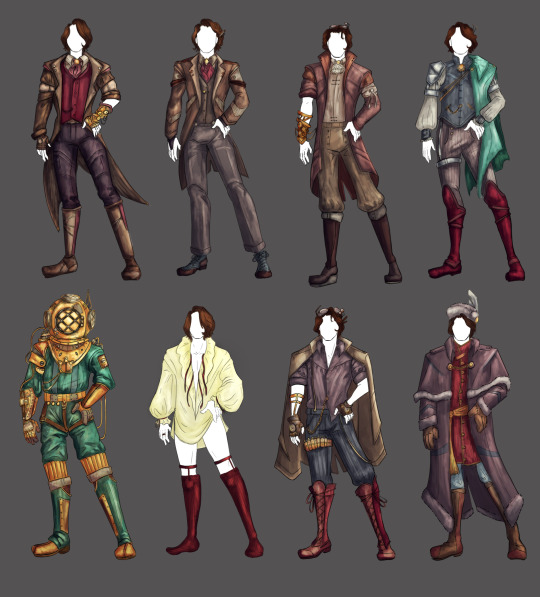
I explored many silhouettes for him as i decided on his rules, ultimately favoring long swishy jackets and large pointed collars. I gave him ruffled shirts and combined with his poses it makes him look a bit like a bird that puffs out their chest feathers, which suits his character. His tighter pants leave the focus to be on his upper body, and contrasts Jack's look.
Jack's clothing design similarly reflects how he's meant to be perceived. He's someone recognizable, familiar to the player and his method of dress is much more earth-like. He's someone you could meet in a city and have lunch with after he's done with his shift.

Jack is a working man who wishes to leave but feels trapped in his life, so his costume needed to be focused on working clothes but showing off his intricate unique tattoo that shows his dream of travel in a kind of direct way.

He also focuses on more bulky pants and shoes with a tighter upper body to contrast Alistair's upper body focus shapes. They are like \/ and /\ together.
For the designs of the Eloré Nabyke citizens, I returned to my Alistair sheet. There was a look with a half cape that I had decided somewhere was what Alistair wore when he was a younger man on Eloré Nabyke.
This then informed the design broadly for the world with half capes and their clasps being signifiers of one's role in society.
At the point in the game the prologue takes place, Alistair is in his red color, so making Eloré Nabyke, or at least this city, have a focus on blue in their clothing would help heighten the otherness of Alistair returning after so long a time away and being an outsider to how his home has progressed without him.
Each character then got their own shows of status in the form of their cape clasps and the fineness of their accessories.
The outfit inspirations are a combination of "medieval" stagewear, 17th and 18th century dress, and small modern influences. By setting the costuming back in time, it's like "you thought alistairs look is dated? Well his home planet is even MORE in the past!" Though the full effect is slightly lost without other space to contrast against.

Temperance, as the youngest, has the most modern influences and she comes off more recognizable. Crabb's overdecorated style makes him more standoffish. Jules' simplistic style makes him more down to earth. Uriah's workwear makes them personable, similar to Jack. Miriam's mix of decor and simple clothes reveals more of her past of her previously holding a high position and has left it to wander.
After the long journey of design, I think it really came together in good kind of way! Keeping in mind the aesthetic clearly is the key to successful design!
2 notes
·
View notes
Note
If you could have muse for your art from the idols, who are 5 people in men and women you would choos and why
ANON!!!! oh man ok. lemme put my thinking brain in.
ok let's talk some basic logistics. muse implies using the idol themselves as inspiration, which is not something i normally do in my personal practice but i will gladly indulge for this thought experiment. the way that makes the most sense for me to approach this like brainstorming concepts/projects that i would like to use these particular idols for, if i had infinite money/opportunity yadda yadda.
ok ok ok. let's go:
taemin - this one was probably a no brainer, but i have a theoretical taemin comeback that i'd love to be the creative director for and it lives rent free in my brain all day every day. as for why; i think he'd be a really interesting collaborator and he's very versatile as a performer no matter what people have said about his acting (final life was a bad script ok, it wasn't all him!). we have very similar ideas and interests and i think it would be fun.
woodz - i would kill to work on a comeback with him because same reasons as taemin, he's smart and talented and has a very clear confidence in performing and i want to push that as far as it can go. but really what i want to do is shoot and style like a dozen different magazine spreads of him. so badly. he models so well.
hongjoong - please refer to this post that is sort of a joke but also absolutely not a joke one day i am going to direct this kid in a play and then you will all SEE
ten - baby you are WASTED as a boy group member. his skill in contemporary and urban choreo are rare for an idol and he's already got the theatricality; i wanna do a series of installation performances with him about identity + presentation because i think he could really deliver on how he shows conflict and that slippage between performer and person and audience. also he speaks what? four languages? more great material.
san - i think he has soooooooo much potential and he's worked so hard to improve since debut and i want to throw him in more stuff that pushes his limits since he's also interested in acting. see in aforementioned hongjoong post that i'm casting him as guildenstern in rosencrantz and guildenstern are dead, but also yea i'm gonna shoot like a dozen magazine spreads of him too. including one that's an unrealistic glamourization of college house parties in the mid 2010s. just because.
sunmi - also a no brainer, she's smart and beautiful and has a very good understanding and depth of theme in her work. would absolutely die to shoot an mv styled like that 17th/18th century revival that happened in the 80s; i'm talking draughtsman's contract/dangerous liaisons/amadeus but reintroduce some 80s aesthetics into it. we're gonna use some stuff from the thom browne ready to wear spring 2020 collection and it's gonna be insane. i can think about theme later. i'll come up with something.
cl - the alpha performance video bit me in the fucking ass. she and her stylist were on something for most of those mvs for that ep and i want to push the pseudo art deco thing they gestured vaguely at even further. i love that she understands fashion and how to actually use it (see her appearance at the met gala) and i wanna get in there and play. doesn't have to be a whole comeback specifically but at least a performance video for sure.
sunye - not ashamed to admit this choice is mostly because she is SO beautiful, but i really want to blow her hair out to full farrah fawcett and shoot a summer 70s themed magazine spread. she's got the face and the presence and i think it would be really cute to put her in some british mod/twiggy type mini jumpsuits and have her zip around on a penny board at the beach.
hyolyn - i loved her coming of age ceremony stage with junsu and this hit me like a bolt from the blue and it doesn't have much more justification than 'she's got a bigass cross tattooed on her abs' but i would LOVE do to some borderline blasphemous catholic inspired styling. or just use her for an incarnation for one of my passion projects about christian iconography.
boa - please queen i would do anything for you just ask. blank cheque no questions.
#also please note that i would also write a blank check to work with key#key is actually at the top of my list for 'people i would like to work with at some point in my life' but i wouldn't classify him as a muse#i just think it would be a really fun experience and we have very similar ideas etc etc but i dont have like. a specific idea in mind yanno#basically my reasons for a lot of these are either 'i see potential' or 'theyre smart + their work says that they have similar ideas as me'#there's also some groups i would love to design a comeback for but i don't necessarily have any standout ideas:#oneus + onewe. purple kiss#red velvet. shinee. a.c.e#tbh i would do any solo cb for a shinee member who am i kidding#kpop questions#i dont know if everyone knows but i am actually a photographer also. that's why there's a lot of magazine spreads here#general design questions#text#answers#anon this is such a good ask thank you SO much#im not gonna tag all these idols there's too many
10 notes
·
View notes
Text
Familiars: what are they?
This is something that comes up every once in a while and lately has been coming up a lot, so we should discuss familiars. It is largely thanks to modern commercialization of misconceptions from the European witch trails that we get our current misunderstandings of familiars. So let's breakdown the history and perceptions of familiars to get a better grasp of them.
Familiars are a kind of tutelary spirit, a non-corporeal intelligence that a witch/magician summons and binds to themselves. In a way, they are like a servant to the witch, but under some conditions. For instance, the magician needs to appease their familiar to keep its company. If a familiar feels that the magician has violated the terms of their pact, they will leave and may even harm the magician. Likewise, if the magician were no longer happy with the services their familiar provided, or they felt their familiar was leading them into danger, they would banish them or call on another spirit to send it away forever. Ultimately, assuming a good bond has been made, the familiar will stay with the magician for the remainder of the magician's life, as familiars do not die. They're spirits, so they don't die. They will assist in magical practices, teach, heal, fetch money, fetch mightier spirits to help, et al. In return the magician will give shelter, food, water, and whatever else the witch-familiar compact may have an agreement on.
The oldest and closest thing we have to the modern idea of a familiar are the household gods of the ancient world. Even as cities developed, individual households had their own gods. It isn't until much later that we see cities and states develop their own "household gods" or gods of the city.
Prior to the Romans there does not seem to be much of a distinction between household gods and the larger religion gods. But the Romans had three different names for these sorts of spirits that give us some clear distinctions of the perceptions these people had of their gods: genius loci, dii familiares, and lares. The genii loci were "spirits of place," and were spirits that governed and protected a specific area, such as a neighborhood, a crossroad, a forest, etc. Genii loci that governed a household were called lares. These were the household gods that residents set up shrines to just inside the doorway, a common practice to this day. Then there were the dii familiares, which were something like the lares, but watched over the whole family, as the family did not always stay in the home, but expanded, moved, went to the market, etc. If these household gods were not kept happy, they would leave the house and family, leaving them unprotected, and may even come back to harm them.
We see evidence of this in the Bible, particularly in Genesis where Rachel steals her father's household idols. Eventually there would be state genii loci, lares, and dii familiares, such as Roma personified as a goddess in her own right. Hermes was also a genius loci, usually at crossroads. Enodia (Hecate) was another crossroads genius loci. However these two gods become more state religion deities with their servant spirits watching over crossroads. Jehovah is very much like this with the ancient Israelites, even having a pact, i.e. the Covenant, of which the Ark of the Covenant was a fetish object to house God.
However, truly the oldest idea of a familiar is the personal daimon or demon, a specific daimon that is assigned to each person at birth. The oldest complete example of conjuring a personal daimon is described in the first portion of the Greek Magical Papyri, a collection of magical spells and rites dating between 1st century BC to 5th century AD. This rite details how to conjure a daimon that will be bound to the magician, and will teach and guide them, dine and sleep with them, and be with them until the end of the magician's days. Socrates himself may have had something like this when he refers to his daimonion, a "divine something" that advised and guided him, but never controlling him.
This personal daimon becomes a central feature of western magic. In Byzantine magic, such as in the Hygromanteia, the daimon becomes something akin to the dii familiares, though distinctly personal to the magician and the same familiar can be passed from master magician to apprentice (such as Dr. Faustus to his pupil). All grimoires been the 13th and 18th centuries have a rite to conjure a familiar or to conjure a spirit to bring a familiar. A great example of this is in the Ars Goetia where several demons are listed as being good for bringing familiars. Similar examples are found in spirit registers such as in the Grimorium Verum. Even folk magic includes ways of gaining a familiar, and the rites are usually a lot more simple than the formal ceremonial magic of the Renaissance grimoires. These are found in various Secreti or books of secrets (see for instance Treatise of Magical Secrets and Mixed Cabala, trans. by Rankine and Skinner)
Our current conceptions of a familiar come from the witch trails of the 16th and 17th centuries. Prior to this time period magic was not exactly forbidden. Magic was usually something that was tacked onto other charges, usually treason. Since magicians held their reputations via rumors and recommendations, and rumors are what Oliver Cromwell sought to destroy, thus witchcraft enters the courtroom thanks to such rumors of magicians. As witchcraft becomes chargeable on its own in the 16th century, we see players like Matthew Hopkins enter the stage. These "witch hunters" were nothing more than opportunistic assholes who used Cromwell's methods of hunting via rumors. Anything could be used as evidence of a witch, and townsfolk often used these opportunities to get rid of someone they didn't like by accusing them of witchcraft. Most of the people, usually women, though there were plenty of men tried as well, who were accused of witchcraft were not actually witches. They could just be lonely old widows that have a dog or a cat to keep them company.
Familiars, or rather pets, were a common way of determining if someone was a witch, since that was part of being a witch. However, people back then had pets like anyone today. So these women who were seen as unusual and therefore a witch, had their pets used as evidence against them. And really, they were like many of us: they had a close relationship with their pets, talked to them, really cared for them, took them everywhere with them. This all sounds strangely like a familiar, and to opportunists like Hopkins, it was the perfect rumor to locate a "witch." But really it was just an excuse to kill a quirky old woman no one liked who lived alone and loved to talk to her birds, and someone else probably really wanted her land.
Much of this pet as a familiar has become sensationalized today. In a way, yes, you can conjure a familiar to inhabit the body of your pet. In the Renaissance, possessing an animal with a spirit was no big deal. Today that would probably be seen as unethical to your pet. But there really is no need for this, as a spirit will physically appear to a magician at their command, and can even take on familiar forms such as a dog if the magician requests it. It is not uncommon to see in Renaissance grimoires a portion of the conjuration includes the magician stating, "appear to me in a pleasing form."
Further, it's borderline animal abuse to truly treat your pet like a familiar. A lot of energy is exhausted by familiars to be your servant, but they're spirits and can usually handle it, and if they can't, they go get you a bigger stronger spirit to handle it. Pets cannot do that, and they shouldn't have to. To truly use your pet as a familiar will most likely harm them in the long run. Pets should be treated like family, not your magical teacher and conduit.
In practice, the familiar can be almost any kind of spirit. In the Abramelin rite the familiar is called the Holy Guardian Angel, a divine heavenly entity assigned to each person at birth. In the Faustian tradition, the demon Mephistopheles is Dr. Faustus's familiar. In the Christian tradition, the Holy Spirit acts as a sort of familiar to Jesus, assisting Jesus with his miracles, and according to Paul raised Jesus from death. But familiars can also be souls of the dead, such as ancestors. In fact, the lares and dii familiares may have been ancestors of that family/household that always stuck around to watch over everyone, and later became deified.
So while our pets are very important to us and can even be a bit magical, they are not the same as a familiar. And in many ways it's wrong to say they are. It takes something that was viciously used to torture and kill lonely old women and sensationalizes it into an aesthetic, rather than a way of life, a devotion, and a compact you keep and renew each and every day with the same entity. And to make your pet an actual familiar is abusive. Having a tutelary spirit (or several) is central to western magical practices, but it is not the same as having a pet. If you want to get a pet, get a pet. If you want a familiar, there are hundreds of ways to conjure one up and make a lifelong pact with it.
The reason this is important to understand and differentiate is so you become a better pet owner and a better witch.
Franklin
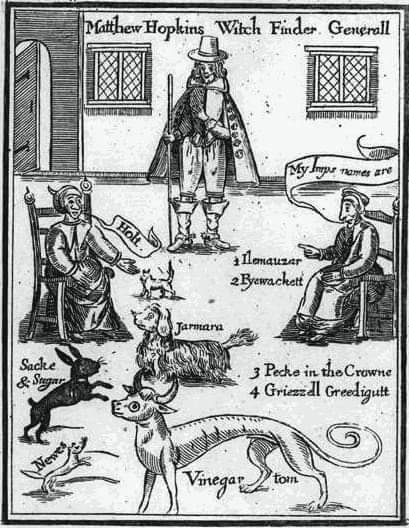
Image: Matthew Hopkins, "Witch Finder General" (a title he made up) investigating witches and their familiars.
9 notes
·
View notes
Text
McMansion Hell Does Architectural Theory (Part 3): British Palladianism
Hello Friends! Today we’re going to talk about a rather short-lived movement in late 17th, early-18th century architecture: British Palladianism, which is v “Palladio is great and I, an aristocrat, will only pay you if you design in reference to his style.” Of course it goes deeper than that, so, let’s begin!
Background
In previous installations of this series, we’ve talked about the Italians and the French, but what the heck was happening in Britain all this time? Well, the answer is:

Seriously. The dang Brits were at war all the time - colonializing everything, sinking all of Spain’s ships, creating their own cool church bc their king wanted a son etc.
Because of all this dang war, architecture in Britain for a long time was a messy hodgepodge of stylistic elements. Examples range from Henry VIII’s Windsor Castle Gatehouse (OG Tudor, though ostensibly Gothic) to the more classically-oriented but still rather Gothic Old Somerset House (completed in 1552) (demolished). According to Mallgrave’s Architectural Theory (a great anthology), most of the classically inspired elements on pre-17th Century British buildings can be traced to Italian or French artisans. Oh well.
Early English Classicism (Late 17th Century)
It wasn’t until the 17th century (v late) that classicism became a big deal in England. The first real-deal English classicist was the badass-ly named Inigo Jones, who actually went to Italy for a year (1613-14) where he encountered the work of Palladio for the first time -- which, needless to say blew his damn mind. Jones became the first British architect to have designed buildings in accordance to Vitruvian teachings and classical proportions.

The Dude Jones got into architecture through a weird angle: he was first a prominent set and costume designer for several English theatres. His Italian journey proved fruitful for him career-wise - many of the higher-ups were impressed with Jones’ knowledge of Italian aesthetics, and he was shortly appointed as the Surveyor to the Prince of Wales, before hella upgrading to being Surveyor of the King’s Works in 1615.
Jones’ earliest known architectural work (appropriately called Queen’s House), built for James I’s wife, Anne (who died before it was finished), was the first ever classically styled building in England. I mean, it’s great - just look at it.

Photo by Bill Bertram (CC-BY-SA 2.5)
While Jones would go on to design a smattering of buildings, a great deal of his work was lost both in the English Civil War and in the 1666 Great Fire of London. Despite these minor setbacks, Jones’ is still considered to be among England’s greatest architects whose influence would span two centuries worth of British architectural technique.

Get it? It’s lit? Because half of his stuff got torched? I’m sorry.
As far as architectural theory goes during this era of budding classicism, the closest clue we have is the work of Henry Wotton, the British ambassador to Venice, who got so hellaciously sloshed on Italian architecture while he was there that he decided to write a book about it called The Elements of Architecture (1624), outlining his special interpretation of classical architecture.
Wotton’s book was mostly a translation of Vitruvius with a little bit of Renaissance thought (a la Alberti and Palladio) thrown in. The most well-known snippet is his translation of the Vitruvian triad as “firmness, commodity, and delight” - an architectural catchphrase that often finds its way into contemporary architectural histories, though more accurate translations have been proposed:
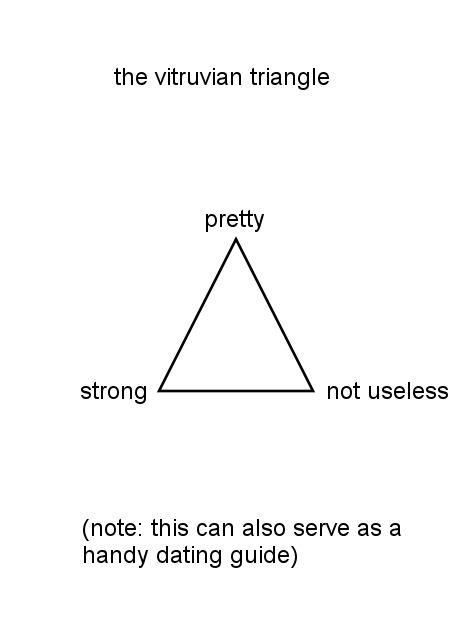
Change in this line of thought came with Jones’ later successor, Christopher Wren. Unlike Jones who was rather rigorous in his classicism, Wren was a bit more...capricious. In fact, he even built in the Gothic style at the end of his long career (the dude built 45 churches alone) - a move that would have likely put Perrault and Blondel both in an early grave.

Dude doesn’t even need the sunglasses, he’s throwing so much shade in this pic.
Wren’s ideas about architecture, encapsulated in his Tracts on Architecture (1670s) are varied. In Tract I, Wren opens up with the ballsy af statement: “Architecture has its political Use,” - that is, buildings form the national identity of a country and inspire patriotism amongst its citizens. This itself is a hot take, but it gets even hotter.
Like Perrault, Wren’s ideas about beauty are split into what he calls “natural” and “customary” beauty. Natural beauty consists of geometry, aka Proportions, following in the Platonic tradition® of an absolute beauty or harmony, inherently pleasing to all of us. Customary beauty, however, is more vague - Wren describes it as: “the use of our Senses to those Objects which are usually pleasing to us for other Causes, as Familiarity or particular Inclination breeds a Love to Things not in themselves lovely.”
Basically, we like certain things for some dumb reason like feelings and stuff.
In his second Tract, Wren gripes about architecture being “too strick and pedantick.” This makes sense, because Wren was really into blending a variety of interesting styles together, which was perhaps problematic to some.
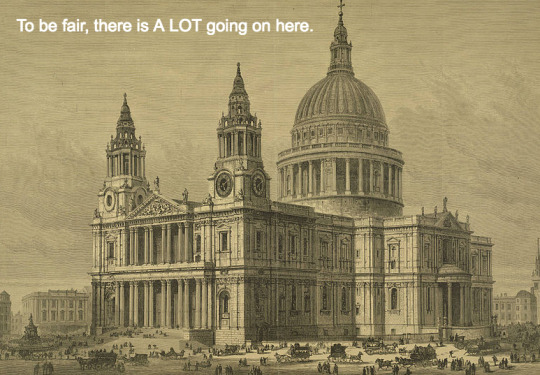
Enter the Moralists
One person who was particularly sick of Wren’s sh*t was Anthony Ashley Cooper, Third Earl of Shaftesbury, who, in addition to being an Earl, was also a writer and philosopher. (He was notably taught at a young age by none other than John Locke, the guy you learned about in Civics class once.)

Shaftesbury hated (!!!) the Baroque stylings of Wren’s late work, as well as the next generation of architects including John Vanbrugh and Nicholas Hawksmoor, deeming the pair’s Baroque-leaning Blenheim Palace “a new palace spoilt.” In fact, he wrote a very amusingly scathing essay in 1712 basically saying that Britain was literally *THE BEST* at all of the other arts except for architecture, after which he proceeds to take a huge dump all over the architecture of the day.

Photo by Derova, (CC-BY-2.0)
Shaftesbury tried to sniff out a philosophical basis for Platonic thought regarding absolute beauty and harmonic proportions. What he came up with is essentially moralism, claiming that in order to be able to perceive the naturally good and beautiful ideas in art, one must themselves be naturally good and beautiful on the inside.™ Good taste comes from good inner resolve® to be true to what we know is true beauty and not be swayed by the evils of fashion™ blah blah blah.
The Height of British Palladianism
This line of thought continued within what was now deemed British Palladianism (a movement whose discourse consisted mostly of wealthy Earls tutting at each other). British Palladianism saw several architects (Colin Campbell, Nicholas Du Bois, and William Kent, specifically) launch their own careers by releasing translations or new editions of works by Vitruvius, Palladio, and Jones, respectively with some pithy bits in the introductions haranguing the “ridiculous mixture of Gothick and Roman” of the previous generation thrown in for good measure.

Like all movements, the Palladian movement had its own shadowy figurehead, who funded the work of several of the architects working in the 1720s - Richard Boyle, Third Earl of Burlington.

Burlington was extremely wealthy, and spent most of his time being a total dilettante architect, traveling to Italy to collect manuscripts of Palladio and the like. In fact, Burlington fired Colin Campbell (the English Vitruvius!!) from working on his Piccadilly Villa because apparently Campbell’s classicism was **just not pure enough** for the good Earl, who decided he should just build his damn villa himself.
Burlington’s ruthless aesthetic commitment had a huge impact on the contemporary architects of the day, most of whom he fired. Of the ones he did not fire (aka he did not hire them in the first place), Robert Morris, the most prolific writer of the Palladian movement, is perhaps the most significant. Morris’s work chronicles not only the dawn and spirit of the movement but also its decline.
Morris’s 1728 essay “An Essay in Defense of Ancient Architecture” is about exactly what you would expect:

(((Tutting intensifies)))
The essay of course devolves from tutting critique to legit 17th century fanfiction:

I-Inigo-sama!!! <3
The End of an Era, I Guess
Jokes aside (yours truly used to ship historical figures back in my 7th grade fanfiction days and is not proud), Morris would take a rather different tone in 1739, in an essay commonly cited as a hint to the movement’s end, “An Essay upon Harmony.”
This essay breaks away from the Platonic ideas of absolute beauty, and instead breaks beauty up into several different categories - a relativist aesthetics coming from a contemporary movement (mostly in landscape architecture) called the picturesque, or picturesque theory, which will be the subject of next week’s post.

“In Harmony,” writes Morris, “there are three general Divisions, which may be distinguish’d by the Terms, Ideal, Oral, and Ocular.”
The Ideal is of course numbers and, duh, proportions. Oral harmony is how things are related to each other, with a v Plato allusion to musical harmony. Old news, right?
But it’s Ocular harmony that offers a glimpse into what will ultimately be a much more powerful movement, spanning (serious, not dilettante) philosophy, art, and of course architecture: the picturesque and the sublime, supported by John Locke & Co.’s empiricism (but we’ll get to that).
Ocular harmony is the harmony of nature in its natural state - both “Animate” (animals, insects, also beauty and perfection, apparently) and “inanimate” (hills, woods, valleys, scenery - “noble, rural, and pleasing.”)

Morris’ ideas are ones of subjectivity, blind sensation to what is and is not lovely, rather than dictated ideas of aesthetic morality. He later goes on to say that in architecture, “The Proportion should be with respect to the Situation; the Dress, Decoration, and Materials should be adapted to the Propriety and Elegance of the Situation and Convenience…”
If that’s not the antithesis to Burlington’s objective classicist purity, I don’t know what is. And so, the bell finally tolls on British Palladianism.

Photo by Chris Nyborg, (CC-BY-SA 3.0)
I hope you enjoyed this bit of (admittedly long-overdue) tutting. Stay tuned for Wednesday’s Maine McMansion, and next Sunday’s installment where I trash talk a bunch of dudes who are way too into gardens.
If you like this post, and want to see more like it, consider supporting me on Patreon! Not into small donations and sick bonus content? Check out the McMansion Hell Store - 30% goes to charity.
Copyright Disclaimer: All photos without captioned credit are from the Public Domain. Manipulated photos are considered derivative work and are Copyright © 2017 McMansion Hell. Please email [email protected] before using these images on another site. (am v chill about this)
#architecture#history#architectural theory#palladio#philosophy#aesthetics#inigo jones#christopher wren#robert morris#england#british palladianism#classical architecture#classicism#traditional architecture#theory
446 notes
·
View notes
Text

This past Spring, my boyfriend and I took a trip across Europe in celebration of him graduating and getting a new job, along with my need to explore. Over the course of nearly three weeks, we explored five countries, eight cities and their surrounding towns and parks. It was an ambitious trip, and we were exhausted by the end, but I wouldn’t have traded it for the world. All Travel Logs focused on the trip will be linked with #Akron2Europe. I’ll also provide some small tips that helped make our lives easier.

Amsterdam, with its winding canals that crisscross the city, has a sort of charm that I don’t think I appreciated as much while I was there. Starting as a 13th-century fishing village, Amsterdam has grown into a major hub for business, culture, and tourism. Much of its characteristic cityscape developed in the 17th century, during the city’s Golden Age. Towards the end of this age, the Dutch Republic was under attack by both the French and English, but still remained an important hub and financial centre of Europe. Today, the city is known for its extreme tolerance. My fellow LGBTQ friends will find themselves right at home here.

This city is home to some of the most famous museums and artists in the world. Does the name Vincent Van Gogh sound familiar? Its language has Germanic roots and, similar to Ireland, I don’t think I realized how expansive its use was. I always thought of Netherlands as a country where most people spoke English. I know how foolish that was of me to assume but I’ve learned my lesson. This was the moment when it settled in that we were in a completely different part of the world.
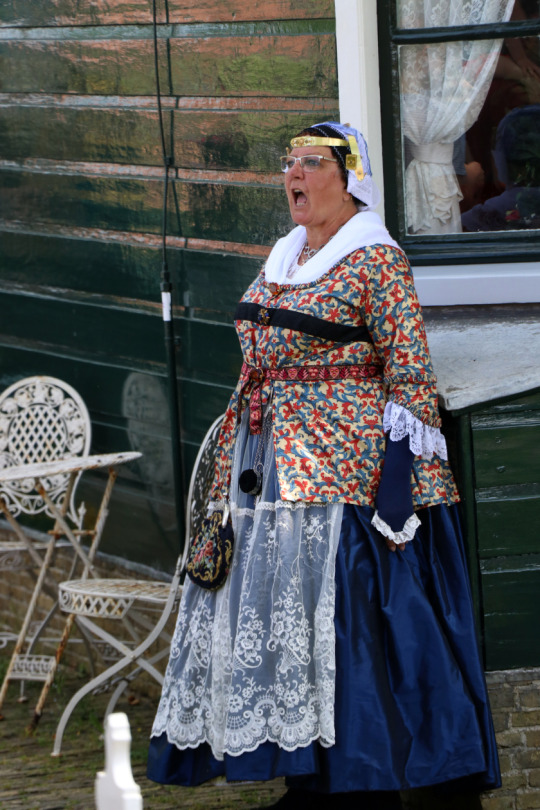
The most diverse city in Europe, Amsterdam boasts over 180 different nationalities and is 45% ethnic minorities. Because of this diversity, we blended in fairly well and many people who approached us spoke in Dutch, which was a bit jarring. We had an incident where we had to wash clothes in Zaandam and we went to a laundromat where none of the employees spoke English. We had to use non-verbals and, with the help of a customer who spoke patchy English, we were able to get our closed washed, dried, pressed, folded, and packed for 16 Euros!

This is the first city where we actually got a chance to try out their public transportation system. Taking the Sprinter train from the airport to Zaandam was one of the smoothest experience I’ve had while transporting luggage. We stayed at the Easy Hotel Zaandam, a budget hotel that gives you the bare essentials, but it was clean and simple for what we needed (and later I’ll talk about why I’d probably not choose this hotel again event though it was a good experience).
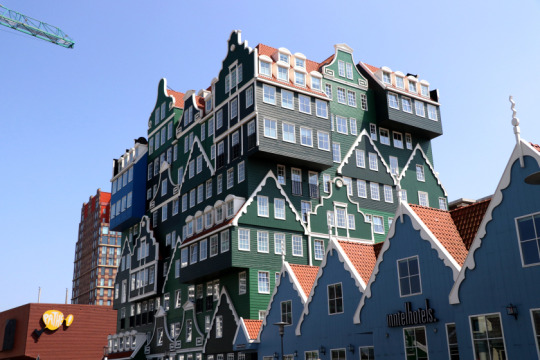
Zaandam is a city on the Zaan river in North Holland next to Amsterdam. The architectural style is incredibly funky when you step out of the train station. You could tell that this was a shopping centre and overall isn’t a very exciting place to be. Many of the restaurants close early and we ended up arriving during Pentecost Sunday and Monday which hindered a lot that we could do. Needless to say, we didn’t stay in this area very long on any given day.

The Openbare Bibliotheek (Amsterdam Public Library – Central Library) was one of my favorite stops in the city. The towering library reminded me of Seattle’s Main Library with its large glass windows, clean aesthetic and pops of color. The dim lighting and backlit shelves in certain areas were an interesting choice and made me feel like I was in a cozy cavern. I found the comics section relatively quickly and I weaved my way through the shelves chuckling as I flipped through Calvin & Hobbes, not understanding a word of Dutch.

Most of the days in the city was spent wandering the canals and I will admit that I did not enjoy my time in the Red Light District. I was disheartened to find that a lot of the shop windows sat empty and people were gawking at the women who where there. I understand the attraction of the area, but I wish that it was less of a spectacle. Everyone has to make money somehow.

I was thoroughly impressed with their biking culture. Approximately 58% of people in Amsterdam over 12 cycle daily and the city has nearly 480 miles of cycle paths crisscrossing the city. Many of these paths are separated, elevated cycle tracks, and they’ve used the physical landscape to force drivers to conform to the set speed zones (30mph and 18mph). These traffic-calming elements like narrow streets, speed bumps, and textured pavement pepper the area and not once did I feel like I would get hit by a car. A bike, on the other hand, is a different story.

In my line of work, we often point to cities like Copenhagen and Amsterdam as examples of how biking can be a viable transportation option. This frame of thought is fine as long as we make sure to balance it out with the realities we face in American cities. Both Amsterdam and Copenhagen have not only undergone a cultural transformation, but also a physical one that has taken decades to accomplish. These cities are also very flat. When approaching building a bike network in a hilly, Rustbelt city like the one in which I live, we have to provide different solutions to address these different obstacles. I’m not saying that it can’t be done, but we have to think creatively about it and work with those who, despite the barriers, are already cycling regularly.

As an artist by nature, I cannot not stop by the area’s art museum. This bold, beautiful building took my breath away. Rijks Museum is the Dutch national museum lated in Museum square. It was 17.50 Euros per person (set to increase to 19 Euros in 2019). It features many of the greats including Van Gogh, Rembrandt, and Vermeer, but also some stunning costumes, wood work, and ceramics.
I could take two days to explore this place and probably barely scratch the surface. I find it very interesting how curators organize exhibits and what stories they wish to tell about the history of a place. When I decide to go back, I’m going to spend more time exploring Museum square. On our way back, we did stop into a couple shops and an art gallery that was showing Banksy’s work. It was really cool to see their work in person after hearing so much about them and seeing them used through memes across the internet.

Pivoting a bit, the Dutch countryside is a site to behold. We took a quick jaunt out to Zaanse Schans to see the windmills and try some of their incredible chocolate. This neighborhood in Zaandam features historic windmills and houses from the 18th and 19th century, as well as many handcraft shops and museums. It is, without a doubt, a tourist destination, but if you’re only in the area for a few days and you want a taste of the countryside, this is the place to go.
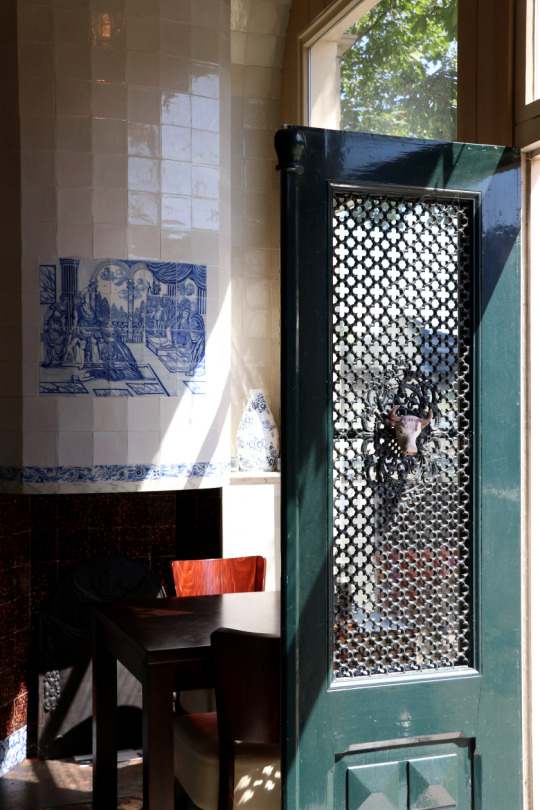
The main portion of the neighborhood smells of roasting chocolate that can be a bit overwhelming if you’ve never experienced it before. There are shops and residential areas that fill the space and people zigzag through the streets on bikes. It’s honestly very chill. We had a pleasant meal at a small shop that we quickly found out only took Euros (and Discover!), but had some of the best coffee in the area (luckily we carried just enough). It was early so we were the only two inside the restaurant, but the outdoors quickly filled up.

Across the bridge is a recreation of a historic village featuring the actual 18th and 19th century windmills that were moved down the waterway to this area. After a short stroll along the path and taking in the scenery, we took some time to relax by one of the canals. This felt like the first time we truly stopped moving during the whole trip. I can still feel the way the stress melted off my shoulders and I sighed in contentment.
There were a lot of laughs and a lot of exhausted moments by the time we made it to Amsterdam. We had been on the go for nearly five full days without rest and I believe that it may have colored my opinion on this place initially. When rating all the cities we’d visited, this ranks pretty low on the list, but with a few adjustments, I would be willing to give this place another try.
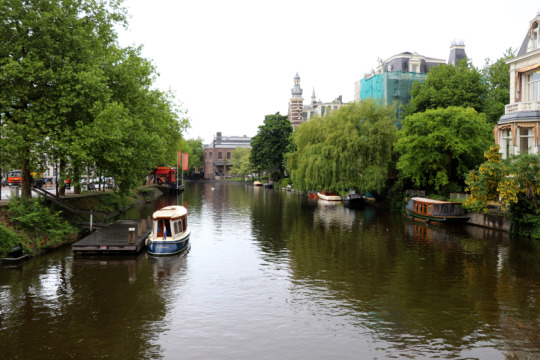
I want to leave you with a few suggestions for those who want to visit. Stay in Amsterdam; trying to be frugal and staying out in Zaandam was one of the first mistakes we made. When booking the hotel, I didn’t realize how long it would take to get into the city, so it hindered a lot of what we could do there. Stay longer; I’d recommend giving this place at least five to seven days to truly appreciate it. I wish I had given this place more time to grow on me because looking back, it was a unique and cool experience. Lastly, I do not understand the obsession with mayo and fries. I will never get it. I don’t want to get it and I hate every second of it. Same goes for hotdogs. No thank you.
Thanks for reading,

Travel Log: Amsterdam/Zaandam This past Spring, my boyfriend and I took a trip across Europe in celebration of him graduating and getting a new job, along with my need to explore.
0 notes